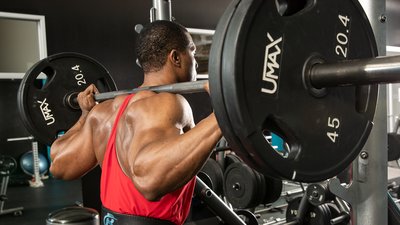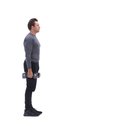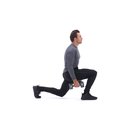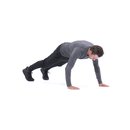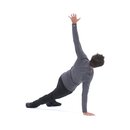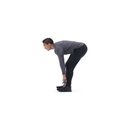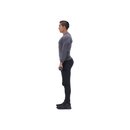A chip-away workout, or a "chipper," takes every lifter's favorite security blanket and rips it away cruelly. I'm talking about your precious rep range. Whether it's 1-5, 8-12, or something else, you pretty much always start your workouts having your work divvied up in convenient little bites, just like Mommy used to cut your food for you.
Not anymore. All of a sudden, it's just you against a big number, like 30, 50, or more. How you break that number up is up to you. If you want this to be over with quickly, well...work faster.
As you might know, these types of workouts are a well-established part of CrossFit programming. But the question, of course, is do these work for outside-the-box lifters who want to add muscle, work capacity, and overall grit? The answer is yes. More and more trainers are realizing that total time under tension and total volume of work matters more than how many reps you do in any particular set.
Personally, I like the idea of the chip-away workouts and the results they give. I've used them since 2010 with myself and my clients, and I love how they cut the monotony of strict sets and reps by putting the focus on finishing a task, much like digging a ditch or cleaning up one's room. But like anything, they can be done in a way that leaves you feeling miserable without providing a whole lot of benefit.
When done properly, however, you can use them to give yourself a test you won't soon forget.
What Is a Chip-Away?
In the Crossfit community, most chip-away workouts dictate that you finish one exercise, perhaps in a single set, before moving to the next. However, I don't think that's the best way to go about it for most trainees. Doing 50 straight reps of an exercise—or 10 exercises, as in the famous "Filthy 50" workout—inevitably results in heavy fatigue and sloppy form, which is a recipe for injury.
Rather, I give a list of exercises and total reps, and tell my clients that it doesn't matter how it gets done. They can pick the exercise order and the reps. Just keep it clean.
Personally, I like to limit the exercises to 6-10, and choose different reps for most of the exercises. The lifter moves from one exercise to the next, doing a chunk of as many reps as possible with good form. It doesn't matter how many reps are performed each time. So, if a chipper contained 50 barbell rows with 135 pounds, the breakdown could look like this:
- Chunk 1: 16 reps
- Chunk 2: 11 reps
- Chunk 3: 13 reps (second wind!)
- Chunk 4: 10 reps
However, most people won't do my style of chip-away workout in 4 sets like that; they'll do something else in between. I prefer to leave exercise order up to the lifter, which is another big difference between this model and the Filthy 50-style chipper. I just give you a list. You choose how to attack it. If you like the "program as written" approach, we can do that. If you want to do all the rows first, fine. If you want spread them throughout, superset them with something else, or save them for the end, that's your choice.
What About Rest?
In a chipper, there is no need for a defined rest interval. Rather, one should move as quickly as possible through the body of work, going from one exercise to the next with as little or as much rest as required. Remember that the goal is to complete the body of work as quickly as possible.
When fatigue gets too great, or form breaks down at any point, it's time to step back, regroup, and rest for...well, as long as you need. But no more.
That said, I do recommend timing the workout. That way, you can measure progress by how long it takes you to complete it in the future. Finishing the same amount of work in less time means your conditioning has increased. Don't be surprised if your muscle increases as well.
Practical Concerns: Weight, Volume, Order
Weight: When choosing weights, I like to keep it at or slightly above a weight that someone would normally use for 8-12 reps with good form. If you're moving quickly, you'll still get great conditioning from it, and regardless of the pace, you'll get a hypertrophy stimulus.
Just as importantly, when fatigue sets in and you start grinding to the finish—which will happen—using these mid-range weights will allow you to maintain solid form. If you're going ultra-heavy, form will break down, and everything gets unsafe.
Volume: Since you will be working with weights that allow 8-12 reps in a typical set, somewhere in the 30-60-rep range will give you a solid time under tension, even if you work hard and manage to bang out 15 or 20 reps all at once. For exercises where you want a pump, you can go even higher than 60 reps. This is especially good for body parts like rotator cuffs, biceps, triceps, and deltoids, and will provide active rest from the big movements.
Here's how I like to distribute reps across movements:
- Low End: 30-45 reps. Compound, more technical movements like squats, deadlifts, lunges, pull-ups.
- High End: 45-60 reps. Single or multijoint moves where form isn't as much an issue, such as rowing variations, push-ups, dumbbell pressing movements, hip thrusts, hamstring curls, and glute ham raises.
- Ultra-High: 60+ reps. More isolated movements like those for the rotator cuff, biceps, triceps, forearms, and shoulders.
The Secret Ingredient: Built-In Active Rest
If your chipper is comprised of squats, deadlifts, pull-ups, push-ups, planks, and kettlebell swings, you'll sure get a heck of a workout. But it will be miserable, and your form will suffer as it wears on. Being miserable and exhausted, contrary to what many people think, is not a sign of good workout programming.
Rather, put in some relief stations that still get the job done, allowing for a breather. These exercises will allow you to rest up before hitting your next set of pull-ups so you can get 7 good reps instead of 4. The ultra-high-rep category of exercises is good for this.
Three Chippers to Build Your Gritness
Now, this may not be what chipper purists want, but I find that separating exercises into 2-3 blocks can make the whole thing simpler and more effective. That's the idea of this particular workout.

BodyFit
$6.99/month- 2,500+ expert-created single workouts
- 3,500+ how-to exercise videos
- Detailed workout instruction
- Step-by-step workout tips
- Training at gym or at home
- Access to Workout Plans
- Access to Bodyfit App
- Store Discounts
Already have a Bodybuilding.com account with BodyFit? Sign In

What comes with BodyFit?

- Instructional Videos
Don't risk doing a workout improperly! Avoid injury and keep your form in check with in-depth instructional videos.

- How-to Images
View our enormous library of workout photos and see exactly how each exercise should be done before you give it a shot.

- Step-by-Step Instructions
Quickly read through our step-by-step directions to ensure you're doing each workout correctly the first time, every time.
All you do is alternate groups until the whole body of work is complete. So, if you do one chunk of reps from a Group A exercise, your next chunk should be from Group B.
Group A is mostly leg exercises, and group B is all upper body. It's a classic superset scheme where one rests the other. The idea is to avoid getting stuck with a ton of reps at the end that work the same muscle groups, which leads to exhaustion and form breakdown.
Are you someone who likes the order laid out for you? Fine. I get that. It's part of the appeal of the Filthy 50, for sure. But the downside to that particular workout is that the reps are pretty much arbitrary, and the workout itself is far from balanced. The middle back and rotator cuffs, for instance, get almost nothing, while the quads and hips get more than enough. Try this instead, either as written or re-ordered to your liking.

BodyFit
$6.99/month- 2,500+ expert-created single workouts
- 3,500+ how-to exercise videos
- Detailed workout instruction
- Step-by-step workout tips
- Training at gym or at home
- Access to Workout Plans
- Access to Bodyfit App
- Store Discounts
Already have a Bodybuilding.com account with BodyFit? Sign In

What comes with BodyFit?

- Instructional Videos
Don't risk doing a workout improperly! Avoid injury and keep your form in check with in-depth instructional videos.

- How-to Images
View our enormous library of workout photos and see exactly how each exercise should be done before you give it a shot.

- Step-by-Step Instructions
Quickly read through our step-by-step directions to ensure you're doing each workout correctly the first time, every time.

BodyFit
$6.99/month- 2,500+ expert-created single workouts
- 3,500+ how-to exercise videos
- Detailed workout instruction
- Step-by-step workout tips
- Training at gym or at home
- Access to Workout Plans
- Access to Bodyfit App
- Store Discounts
Already have a Bodybuilding.com account with BodyFit? Sign In

What comes with BodyFit?

- Instructional Videos
Don't risk doing a workout improperly! Avoid injury and keep your form in check with in-depth instructional videos.

- How-to Images
View our enormous library of workout photos and see exactly how each exercise should be done before you give it a shot.

- Step-by-Step Instructions
Quickly read through our step-by-step directions to ensure you're doing each workout correctly the first time, every time.


